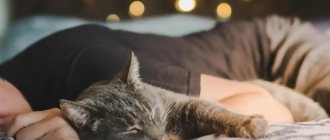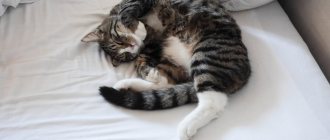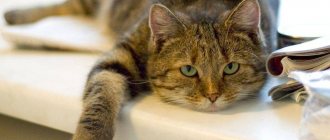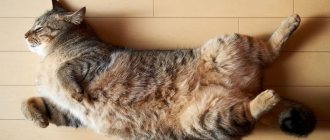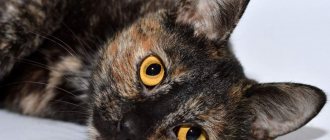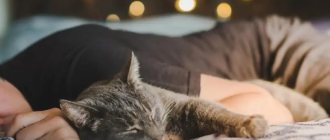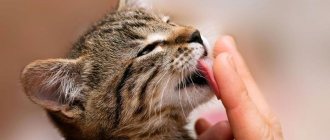Initially, the situation in which a cat attacks the legs and actively bites them does not cause tension, but is most likely perceived as a game. But when this happens quite often, or even every time a furry pet’s feet come into view, and the bites get stronger and stronger, then it’s no longer a laughing matter. It is necessary to take educational measures in such a situation, but before that you need to understand the reasons for such behavior.
Habit of sleeping with a person
They used to say in ancient times that if you sleep in the same bed with a cat, you might get frogs in your head. To a modern person such a legend may seem funny, but if you think about it, it is not without meaning. Imagine the life of a cat, at least a hundred years ago: no vaccinations, walks through garbage dumps and barnyards, free contact with stray animals. Such a pet could “reward” its owner not only with frogs, but also with something worse.
There are many theories explaining why a cat likes to lie on a person. The first of them is esoteric, explaining how cats heal people. Its essence is that a person is like a large battery in which the positive pole is located in the head area, and the negative pole is in the legs, and all the negativity accumulates there. Lying on its feet, the cat takes away negative energy, in other versions it transforms it into positive energy.
Another explanation for why a cat often sleeps on a person is more prosaic: a person, in this case, is nothing more than a source of heat and acts as a heating pad for the animal. The warmest places on the body are the head and the projection zones of diseased organs; cats especially love them and try to lie there. They owe their reputation as healers to this property, and they lie on their legs only because they could be swollen or the owner has problems with the joints. By the way, the Sphynx breed is considered the most “healing” in the cat family; it is suitable even for people prone to allergies.
Another possible reason is the desire for comfort. For a domestic animal, a person is the embodiment of a protector and provider; proximity to him in a dream gives the cat a feeling of security when it cannot observe what is happening around. They are usually driven away from the head or body or hidden under a blanket, which not everyone likes; they have to be content with little, which is why cats usually sleep at their feet.
Theory number four - the animal controls the person in this way. Lying on it, the easiest way is to follow its movements and not oversleep the most interesting part.
And finally, the last theory why a cat sleeps in its legs is scientific, based on its natural characteristics and habits. In cat communities there is a strict hierarchy in which the weakest occupy the lowest level. By lying on their feet, they show their subordinate position and recognize the primacy of the strongest, in this case, man. But if a pet tries to settle on its head or on a pillow, it’s worth asking the question: “Who’s the boss in the house?”
Is it possible to properly organize a place for a cat to sleep?
Cats are territorial, possessive and extremely social animals. They consider every square meter of their home to be their personal territory. Thus, from a young age they will dedicate themselves to patrolling and exploring every nook and cranny of their new household. The cat's instinct, like that of any other animal, obliges them to study their territory and habitat. Cats want to know about everything around them in order to feel safe.
In addition, cats are emotional animals and will therefore be affectionate with all family members. They will play, demand attention and often force everyone in the household to pet them. However, it is normal that there is one person they prefer more than others and is the one they are most likely to want to sleep with.
Source: awto-vesti.ru
If a pet likes to sleep on the legs of a certain person in the family, this indicates that he is the favorite animal. Therefore, no matter what luxurious houses the owner buys for his cat, no matter what soft beds he offers him, man’s eternal companion for centuries, the cat, will still choose the most reliable place to sleep at the feet of his beloved property.
1111
Sleeping on the table
It was believed that if a cat took a fancy to the table, it meant the death or illness of one of the household members, and if it liked to lie on the kitchen table, it meant it was trying to get the man out of the house.
This terrible omen also has a basis. Animals that led a semi-wild lifestyle in ancient times were carriers of many diseases, which ultimately led to sad consequences. And a man’s departure is inevitable if he constantly gets cat hair in his food.
From a scientific point of view, everything is more prosaic; in nature, cats are excellent at climbing trees and climbing up hills because... From there it is easiest to monitor what is happening around them, so the table is a good observation point for them and nothing more.
Sleeping on his back
There is a sign: if a cat sleeps on its back, with its paws spread to the sides, wait for a thaw. If the pet is looking for a place to warm up, frost will strike. These furry barometers can predict weather changes and respond accordingly. Our observant ancestors noticed this long ago.
Modern science considers an animal sleeping in an unprotected position, with its belly open, as simply the highest sign of trust in its owner.
Anatomy of the hind limbs
The hind limbs are much longer and stronger than the forelimbs. This is explained by the increased load on them during the jump.
The girdle of the hind limbs, unlike the shoulder girdle, is fixedly attached to the sacral part of the spine. The legs consist of the pelvis, femur, patella, tibia and fibula, as well as the tarsus, metatarsus and phalanges.
At first glance, it may seem that animals' knees bend in the opposite direction, but in fact this is not the case. The elbow joints on the front legs bend back, and the knees bend forward. What many people mistake for knees is actually a heel - cats' feet are very long. The knees are located at the level of the lower abdomen and are often hidden by thick, long hair.
You can't look a cat in the eyes
It is believed that cats are connected with the world of the dead and can communicate with the inhabitants of the astral plane, who often inhabit them and thus end up in our world. Therefore, looking into the eyes of your pet, a person risks being captured by a hostile entity and becoming possessed or seeing his own death there, by the way, this is one of the reasons why some people prefer not to photograph cats.
Science on this issue, oddly enough, agrees with the mystics, but for a completely different reason. Direct gaze into the eyes is considered a manifestation of aggression in the animal world, so do not be surprised if the fluffy, in response to a long look, suddenly tries to attack you. Ginger cats are the most hostile to staring.
Cats are not allowed to be photographed
Besides the threat of facing your own death ahead of time, there are three arguments against photographing cats:
- Photography can shorten your pet's life. There is an opinion that the image takes away his soul, and this only affects cats, and forces cats to leave the house. The theory is very controversial, as is the fact that cats have a soul.
- Flashlight can impair an animal's vision. A completely reasonable statement. Cats are nocturnal animals and their eyes are not adapted to intense light exposure. There may not be any long-term or irreversible effects on the eyes, but perception may be temporarily affected.
- He may feel stressed and afraid. This is true and especially true for animals that are not accustomed to posing in front of cameras.
We should also not forget that cats are indifferent to photography, people need it, therefore, for the sake of your own ambitions, you should not jeopardize the health and comfort of your pet.
Sense organs
Features of hearing and eyes
A cat's vision provides good vision of its surroundings at night. They distinguish objects and people that move quickly, so these animals are natural hunters. Biological features are the shape of the pupils. They are long and oval. The eyes are closed with the outer and inner eyelids, which prevents external influences. A cat's ear can move to detect the source of a sound. The hearing organs have a unique structure inside and can distinguish the tonality of sound. A cat's hearing acuity is superior to that of a human. If an animal fights, it presses its ears to its head so that they do not get hurt. The movement of the hearing organs occurs with the help of muscles, of which there are 32.
Taste buds
The role of the taste organ in cats is performed by the tongue, which is covered with papillae, giving the surface a rough appearance. Cats easily remove meat from bones and debris from fur by licking it. The tongue contains nipples, which are responsible for the perception of taste. They, unlike other animals, do not perceive sweets. Cats like sour and salty foods. Its anatomical structure prevents cats from spitting out food or dirt from their fur that gets into their mouth, so they swallow everything.
Smell and touch
The organ of smell is the nose. A cat's sense of smell helps determine whether food is fresh. They have a Jacobson organ. It is located in the sky. When cats raise their upper lip, they draw air into their nose through this organ. A cat uses scents to find food, game, or to mark its territory. The tactile organ is the mustache. They have many nerve endings, which provides good orientation in the area. At night, the cat is self-confident. The mustache is connected to visual receptors, through which external factors are recognized.
Vampirism
There is an opinion, which has not yet been scientifically confirmed, that cats are energy vampires and people very quickly become dependent on them. Some people really call it love.
Avid cat lovers also claim that cats only take away negative energy and they do this when they press their warm tummy to you. That is why they love to lie exactly where the owner or mistress is experiencing pain, relieving unpleasant symptoms; older people especially like to be treated in this way when a large bouquet of sores is collected, the heart is playing naughty and the pressure is jumping. Well, all that remains for now is to take this hypothesis on faith.
“It’s your own fault!”
Cats tend to constantly get underfoot. At the same time, they pursue a variety of goals. But many owners don’t really like this behavior, especially in the dark or in a hurry. You don’t want to crush your pet’s paw, but you will!
Next time, try an experiment. You will feel the “cat under your feet”, stop and take a step back. How will the furry mischief behave? It is possible that you yourself once unwittingly encouraged grabbing the legs, and now the animal is trying its best.
Cats are considered difficult to train. It’s not true – these animals are very well trained and understand everything. Cats extremely love and appreciate ANY attention from their owners and associate many other “related” things with it. See what your cat does when you pick her up, pour food into her bowl, open the front door, come home, etc. You may well have unknowingly rewarded your pet with something when he clung to your legs. For example, by paying attention to him!
Probably, now all the parents in the world understand us: for children, even five minutes of parental attention is much more valuable than the eternal “leave me alone” and “don’t disturb.” Thus, cats learn no worse than you and I.
Material quotes: OUCH! Why Do Cats Chase Feet? Source: amyshojai.com Photo: pixabay.com
Purr
There is a belief that a cat predicts the outcome of a situation with its purring:
At the patient's bedside - a speedy recovery.
Sitting on a suitcase - an easy road.
In preparation for the wedding - a happy family life.
Fishermen have a rich catch.
On the guest's lap - a good relationship.
Purring, or rumbling, in cats usually accompanies a state of pleasure, hence the sign - if the cat is happy, then everything will be fine.
Sound originates in the muscles located around the vocal cords, which begin to vibrate under the influence of electrical impulses from the cerebral cortex. It is worth noting that not only cats can purr, but also many other animals: hares, foxes, badgers, bears and even elephants.
The cat is licking or scratching
The habit of cats to lick and comb themselves from morning to evening is reflected in folk signs and, as a rule, promises the arrival of guests or a change in the weather. In fact, the reason for this behavior is not climatic conditions, but a natural desire for cleanliness. A cat will lick anything that seems dirty to it, including its own owner.
Moreover, her concepts of cleanliness do not coincide at all with human ones: hands washed with soap will be licked just as mercilessly as dirty ones. This habit also extends to open wounds, surgical sutures, and bedsores, so veterinarians hinder the process by putting a special collar on the animal.
The second reason for this behavior is the maternal instinct, the pet shows love and care, and the person acts as a child.
